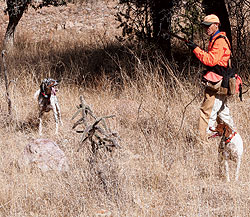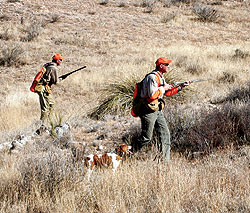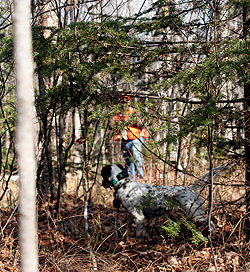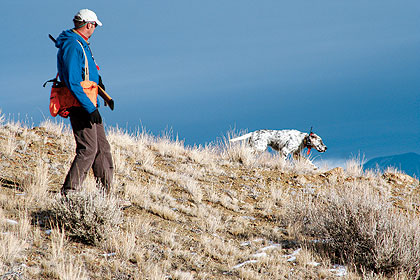Advice on hunting over your buddy's dog.
By Dave Carty
 Walk--don't run--to dogs on point, and keep the safety on until you mount your gun. |
When my friend John let me hunt solo over his best grouse dog, Cinnamon, a few years ago, I was grateful--and surprised. I've yet to turn someone loose with one of my dogs and the day when that happens is no closer now then it was five years ago. It's not that I have any doubts about the care they'd receive--I wouldn't hunt with any of my buddies if I didn't completely trust them--it's just that, if something happened, I would want to be there. That's the irrational side of parenthood, I suppose.
John had been acting as an informal guide to two of us who were visiting him at his Wisconsin grouse camp, and since he and I both feel that three guns going off over a dog's head is one too many, we decided to split up. He and a mutual friend went down one trail; Cinnamon and I went down another.
As it happened€¦nothing happened. Cinnamon glanced over her shoulder once or twice as we left, then settled down to the business at hand and hunted just as hard as she'd been hunting for John and me the entire previous week. When I brought Cinnamon back tired but otherwise hale and hearty, I suspect I'd passed some kind of test.
But that doesn't mean that I'd ask him--ever--to use one of his dogs again. If there was ever an inviolable rule about hunting over your buddy's dog, this is it: never ask to "borrow" his animal.
You can whine, insinuate, make clear your desperation and gaze with pleading eyes until the cows come home, but don't ask. Just don't. Chances are, he or she won't let you; and if he does out of pure generosity of spirit--not something I have to worry about--he may well spend the entire time you're gone worrying about his dog and resenting you for asking. Those few that don't will probably offer you the services of their dog long before you have to resort to groveling in the dirt.
There are two kinds of bird hunters in the world: those who hunt birds in order to run their dogs, and those who hunt over any dog that's handy in order to find birds. Bird dog lovers typically belong in the former category; most of your buddies, the ones without their own dogs, will be in the latter camp.
One of the nice things about owning a dog is that, ostensibly at least, you get to lord it over your non dog-owning hunting partners. That includes making the rules concerning safety, shots taken or not taken, and so on. Several of my friends have begun hunting with unloaded guns recently, loading their weapons only when they walk in on a point.
The issue is safety, and there's no doubt that such a practice is safer, because it eliminates any possibility of an accidental discharge should you trip and fall.
 Hunting in thick cover always calls for an extra measure of caution. |
Last year, a guide I know had a client who walked in on a point with a loaded gun, tripped, and killed the non-slip retriever at his side.
Tragedies like that should never happen, and they won't if you're rigorous about applying safe gun-handling rules: always point the barrel in a safe direction (which means pointing it away from the dogs as well as your hunting partners), keep the safety on until you physically raise your gun to shoot, and walk, don't run, to a dog on point. That's what I do. But if I'm hunting over someone else's dog, and that someone asks that I hunt with an unloaded gun, I do it. It's his dog, and his game to play as he sees fit. For as long as that hunt lasts, I'm just along for the ride.
Same goes for wild flushes. As I've mentioned in this column before, I'm not adverse to taking shots at wild flushes, one of the reasons I typically hunt with a loaded gun. As far as I'm concerned, it all comes down to training--if your dog chases a wild flush out of the country, that dog isn't completely trained, and you've got your work cut out for you. (And yes, my own less-than-perfect dogs have chased birds out of the country, and yes, I did feel like strangling them.)
But that doesn't mean that everyone does it that way. Most dog owners, it is probably safe to say, aren't wild about their yahoo friends taking potshots at every bird that gets up, pointed or otherwise. If they feel that shooting at wild flushes encourages their dog's wayward behavior, what does it matter what I think? It's their dog, and I'm happy to do it their way.
That about covers the more mundane aspects of social protocol; learning how to hunt over someone else's dog is considerably more intuitive. A few years ago, John mentioned under his breath that I was "cutting him off." We'd been traipsing down a logging road, one of his setters ranging somewhere in the woods ahead of us, and I was walking a few steps ahead of him. What he meant, I learned, is that with me out in front, he couldn't hear or see his dogs.
Thanks to a career in law enforcement that included a gig as a machine-gun instructor, John has lost much of his upper-range hearing. He can't hear my dog's high-pitched beepers, for instance, and he can't hear his own dogs over the shuffling of my feet--especially if I'm walking directly in front of him. I stepped to one side, let him pass, and the problem was solved.
The truth is, I'd never thought much about who walks where until that very moment, but from that day on, it suddenly began to irk me if my friends walked in front of me, cutting off my line of sight to my animals. There's something about making visual contact with your dog, especially in thick cover, that reinforces your sense of hearing. And let's face it. The guy with the dog always wants to watch his dog work. Cutting him off deprives him of that pleasure.
 The gunner hunting alone can concentrate all of his attention on his dog's performance, and that's not a bad thing. |
That doesn't mean there isn't some wiggle room here. It's silly and pointless to impose a military regimen on what is supposed to be an enjoyable experience. Nevertheless, I usually let the guy with the dog hunt out in front or to my side, and when someone else is hunting over my dogs, I appreciate--and I certainly notice it--when the
y do the same for me.
Next topic. When your friend's dog goes on point, who goes where? If the cover is open, and you've both decided to walk in and shoot at the same time (rather than taking turns), it's almost always best to move in side by side, a safe distance apart. Without sounding too martial about it, I try to move in and then past the dog in a way that gives me an open field of fire, while allowing my partner to do the same. In other words, I resist the urge to race him to the point.
For a competitive guy like me, that's tougher than it sounds. Everyone wants to shoot--you, me, everybody--and it's hard to resist the urge to gain a step or two on your buddy.
But after having walked up literally thousands of gamebirds, I can say without a doubt that getting to the dog a few steps ahead of your partner rarely makes a difference. You may assume that the bird is right where the dog is pointing, but would you bet the ranch on it? I thought so.
Then, too, there's the much harder to define idea of proper positioning. When my friend Bill and I began hunting together lo these many years ago, I was pleasantly surprised to find that Bill seemed to know right where to go on every point--not too far ahead, but not too close to me, either. Surprised because Bill, who grew up on the east coast, had hunted birds extensively but had never owned a dog. Positioning--his position relative to the dog and the other gunners--was something he intuitively understood.
Most of those who haven't grown up with dogs face a bit of a learning curve. My friend Max is as gun-crazy as anybody I know, but he didn't start hunting birds over dogs until a half dozen years ago, and nearly all of his bird hunting since then has been with me.
Since he doesn't have dogs of his own, it has taken him years to develop a good sense of positioning. Although he still screws up from time to time--nobody's perfect--by and large he's finally getting the hang of it.
Dogs have issues with "positioning," too. In many cases, two experienced dogs, say, yours and your buddy's, will run independently when hunted together, which is exactly what you want. But pairing an inexperienced dog with a veteran can dramatically change the division of labor. Many youngsters will chase the older dog around, nipping at his heels, stealing his points, or worse, flushing birds the more experienced dog has found and pointed.
If you're the owner of the youngster, you may find these growing pains something you can live with--after all, puppies are entitled to make mistakes (true), and in all likelihood the older dog will find birds that the younger dog might have missed (true, but with qualifications).
 Two gunners should advance at the same pace...try to resist the urge to beat your buddy to the birds. |
But the owner of the more experienced dog may not be so charitable. He'll see this, justifiably, as a nuisance his dog didn't ask for and really shouldn't have to put up with.
The solution is simple: hunt the dogs separately. The older dog will be given the peace to do his job, and the younger dog will be forced to hunt on his own. There are those that think an older dog will teach a youngster how to hunt, but don't believe it. Every dog should learn to hunt on his own before he's trusted to hunt with other dogs. And that may take a season or longer.
Backing is another touchy area. Most dogs don't seem to care if they're being backed by another dog, but plenty of owners sure do. Some dogs back naturally, some don't, but if your dog doesn't, you'll have to train him, and until you can rely on him in the field, it's simple courtesy to whoa him if he starts to creep past another dog's point.
Again, this isn't a big issue for me. If one of my dogs breaks when another dog steals his point, I look at it as an opportunity for a correction. My training manual says steady is steady, and once one of my dogs establishes point, I want him to stay there even if the other dog marches by with a nine-piece brass band.
I've saved the most egregious behavior for last. The worst thing you can do is to shoot too close to your friend's dog. If you hunt long enough you may accidentally break that rule--although I can't recall ever having shot too close to someone else's dog, I've certainly shot too close to mine--but it horrified me each time it happened and made me all the more determined not to let it happen again. Trust me on this, your buddy's definition of a safe shooting zone around his dog will be considerably more narrowly defined than yours.
If there's any question whatsoever that a shot you're about to take is marginally unsafe, pass it up. Your friendship will recover from a missed chance at a bird, but a shot dog is something he may never forgive you for.
And finally, as for offering unsolicited advice? Bite your tongue. Your buddy's chicken killing, stone-nosed, run-off SOB is perfect as far as you're concerned.
Any questions?






